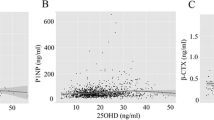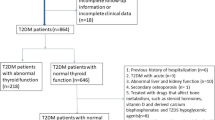Abstract
The effects of intranasal calcitonin on bone metabolism were investigated in patients with hyperthyroidism. Urinary deoxypyridinoline (uDPD) levels were measured as a bone turnover marker and lumbar spine (L2) bone mineral density (BMD) was measured by dual-energy X-ray absorptiometry (DEXA) in 7 patients who were given only antithyroid drug (group 1), in 10 patients who were given antithyroid drug plus intranasal calcitonin (group 2), and in 10 healthy subjects who were given placebo (group 3) at the beginning and at the end of the study. The study continued until the patients with hyperthyroidism became euthyroidic according to the laboratory values. This period was approximately 3 months in groups 1 and 2. At the beginning of the study, uDPD was 21.5 ± 2.6 nM DPD/mM creatinine in group 1, 23.3 ± 3.6 nM DPD/mM creatinine in group 2, and 4.3 ± 1.2 nM DPD/mM creatinine in group 3. uDPD levels measured in groups 1 and 2 were significantly higher than those in group 3 (P ≪ 0.001). Area BMD Z scores of the patients in groups 1 and 2 were significantly lower than the healthy controls (P ≪ 0.01, for both). At the end of the study, uDPD was 11.5 ± 1.6 nM DPD/mM creatinine in group 1, 5.3 ± 0.6 nM DPD/mM creatinine in group 2, and 4.4 ± 1.3 nM DPD/mM creatinine in group 3. The levels of uDPD obtained in group 1 were significantly higher than those obtained in groups 2 and 3 (P ≪ 0.05, for both). The difference between groups 2 and 3 was not significant. Area BMD Z scores measured at the end of the study were found to be increased in groups 1 and 2 compared to early values, but the values were slightly lower than the normal values. In comparison of early and late uDPD values, the decrease in late period was statistically significant in groups 1 (P ≪ 0.05) and 2 (P ≪ 0.001). We concluded that bone turnover is high in hyperthyroidism. The treatment of hyperthyroidism decreases the rate of bone turnover, but it is not sufficient to prevent the degradation of bone in hyperthyroidism. The addition of intranasal calcitonin to the treatment of hyperthyroidism prevents the degradation of bone.
Similar content being viewed by others
Author information
Authors and Affiliations
Corresponding author
About this article
Cite this article
AkÇay, M., AkÇay, G. & Bİlen, H. The effects of calcitonin on bone resorption in hyperthyroidism: a placebo-controlled clinical study. J Bone Miner Metab 22, 90–93 (2004). https://doi.org/10.1007/s00774-003-0455-1
Received:
Accepted:
Issue Date:
DOI: https://doi.org/10.1007/s00774-003-0455-1




